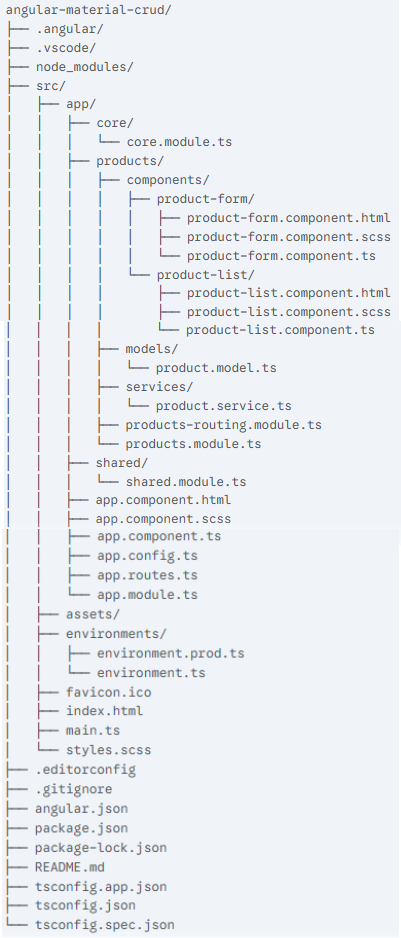Back End
Here's a complete Spring Boot implementation for the backend API that your Angular 17+ Material CRUD app can consume at http://localhost:8080/api.
Project Structure

1. Maven Dependencies (pom.xml)
<?xml version="1.0" encoding="UTF-8"?>
<project xmlns="http://maven.apache.org/POM/4.0.0" xmlns:xsi="http://www.w3.org/2001/XMLSchema-instance"
xsi:schemaLocation="http://maven.apache.org/POM/4.0.0 https://maven.apache.org/xsd/maven-4.0.0.xsd">
<modelVersion>4.0.0</modelVersion>
<parent>
<groupId>org.springframework.boot</groupId>
<artifactId>spring-boot-starter-parent</artifactId>
<version>3.1.0</version>
<relativePath/>
</parent>
<groupId>com.example</groupId>
<artifactId>demo</artifactId>
<version>0.0.1-SNAPSHOT</version>
<name>demo</name>
<description>Demo project for Spring Boot</description>
<properties>
<java.version>17</java.version>
</properties>
<dependencies>
<!-- Spring Boot Starters -->
<dependency>
<groupId>org.springframework.boot</groupId>
<artifactId>spring-boot-starter-data-jpa</artifactId>
</dependency>
<dependency>
<groupId>org.springframework.boot</groupId>
<artifactId>spring-boot-starter-web</artifactId>
</dependency>
<!-- Database -->
<dependency>
<groupId>com.h2database</groupId>
<artifactId>h2</artifactId>
<scope>runtime</scope>
</dependency>
<!-- Lombok -->
<dependency>
<groupId>org.projectlombok</groupId>
<artifactId>lombok</artifactId>
<optional>true</optional>
</dependency>
<!-- Testing -->
<dependency>
<groupId>org.springframework.boot</groupId>
<artifactId>spring-boot-starter-test</artifactId>
<scope>test</scope>
</dependency>
</dependencies>
<build>
<plugins>
<plugin>
<groupId>org.springframework.boot</groupId>
<artifactId>spring-boot-maven-plugin</artifactId>
<configuration>
<excludes>
<exclude>
<groupId>org.projectlombok</groupId>
<artifactId>lombok</artifactId>
</exclude>
</excludes>
</configuration>
</plugin>
</plugins>
</build>
</project>2. Application Properties (application.properties)
# Server
server.port=8080
# H2 Database
spring.datasource.url=jdbc:h2:mem:testdb
spring.datasource.driverClassName=org.h2.Driver
spring.datasource.username=sa
spring.datasource.password=
# H2 Console
spring.h2.console.enabled=true
spring.h2.console.path=/h2-console
# JPA
spring.jpa.show-sql=true
spring.jpa.hibernate.ddl-auto=update
spring.jpa.properties.hibernate.format_sql=true3. Entity Model (Product.java)
package com.example.demo.model;
import jakarta.persistence.*;
import lombok.*;
import org.hibernate.annotations.CreationTimestamp;
import org.hibernate.annotations.UpdateTimestamp;
import java.time.LocalDateTime;
@Entity
@Table(name = "products")
@Getter
@Setter
@NoArgsConstructor
@AllArgsConstructor
@Builder
public class Product {
@Id
@GeneratedValue(strategy = GenerationType.IDENTITY)
private Long id;
@Column(nullable = false)
private String name;
@Column(nullable = false)
private String description;
@Column(nullable = false)
private Double price;
@CreationTimestamp
@Column(name = "created_at", updatable = false)
private LocalDateTime createdAt;
@UpdateTimestamp
@Column(name = "updated_at")
private LocalDateTime updatedAt;
}4. DTO (ProductDto.java)
package com.example.demo.model;
import lombok.*;
import java.time.LocalDateTime;
@Getter
@Setter
@NoArgsConstructor
@AllArgsConstructor
@Builder
public class ProductDto {
private Long id;
private String name;
private String description;
private Double price;
private LocalDateTime createdAt;
private LocalDateTime updatedAt;
}5. Repository (ProductRepository.java)
package com.example.demo.repository;
import com.example.demo.model.Product;
import org.springframework.data.jpa.repository.JpaRepository;
public interface ProductRepository extends JpaRepository<Product, Long> {
}6. Service Interface (ProductService.java)
package com.example.demo.service;
import com.example.demo.model.ProductDto;
import java.util.List;
public interface ProductService {
List<ProductDto> getAllProducts();
ProductDto getProductById(Long id);
ProductDto createProduct(ProductDto productDto);
ProductDto updateProduct(Long id, ProductDto productDto);
void deleteProduct(Long id);
}7. Service Implementation (ProductServiceImpl.java)
package com.example.demo.service;
import com.example.demo.model.Product;
import com.example.demo.model.ProductDto;
import com.example.demo.repository.ProductRepository;
import lombok.RequiredArgsConstructor;
import org.springframework.stereotype.Service;
import org.springframework.transaction.annotation.Transactional;
import java.util.List;
import java.util.stream.Collectors;
@Service
@RequiredArgsConstructor
public class ProductServiceImpl implements ProductService {
private final ProductRepository productRepository;
@Override
@Transactional(readOnly = true)
public List<ProductDto> getAllProducts() {
return productRepository.findAll()
.stream()
.map(this::convertToDto)
.collect(Collectors.toList());
}
@Override
@Transactional(readOnly = true)
public ProductDto getProductById(Long id) {
Product product = productRepository.findById(id)
.orElseThrow(() -> new RuntimeException("Product not found with id: " + id));
return convertToDto(product);
}
@Override
@Transactional
public ProductDto createProduct(ProductDto productDto) {
Product product = convertToEntity(productDto);
Product savedProduct = productRepository.save(product);
return convertToDto(savedProduct);
}
@Override
@Transactional
public ProductDto updateProduct(Long id, ProductDto productDto) {
Product existingProduct = productRepository.findById(id)
.orElseThrow(() -> new RuntimeException("Product not found with id: " + id));
existingProduct.setName(productDto.getName());
existingProduct.setDescription(productDto.getDescription());
existingProduct.setPrice(productDto.getPrice());
Product updatedProduct = productRepository.save(existingProduct);
return convertToDto(updatedProduct);
}
@Override
@Transactional
public void deleteProduct(Long id) {
productRepository.deleteById(id);
}
private ProductDto convertToDto(Product product) {
return ProductDto.builder()
.id(product.getId())
.name(product.getName())
.description(product.getDescription())
.price(product.getPrice())
.createdAt(product.getCreatedAt())
.updatedAt(product.getUpdatedAt())
.build();
}
private Product convertToEntity(ProductDto productDto) {
return Product.builder()
.name(productDto.getName())
.description(productDto.getDescription())
.price(productDto.getPrice())
.build();
}
}8. REST Controller (ProductController.java)
package com.example.demo.controller;
import com.example.demo.model.ProductDto;
import com.example.demo.service.ProductService;
import jakarta.validation.Valid;
import org.springframework.http.HttpStatus;
import org.springframework.http.ResponseEntity;
import org.springframework.web.bind.annotation.*;
import java.util.List;
@RestController
@RequestMapping("/api/products")
public class ProductController {
private final ProductService productService;
public ProductController(ProductService productService) {
this.productService = productService;
}
@GetMapping
public ResponseEntity<List<ProductDto>> getAllProducts() {
return ResponseEntity.ok(productService.getAllProducts());
}
@GetMapping("/{id}")
public ResponseEntity<ProductDto> getProductById(@PathVariable Long id) {
return ResponseEntity.ok(productService.getProductById(id));
}
@PostMapping
public ResponseEntity<ProductDto> createProduct(@Valid @RequestBody ProductDto productDto) {
ProductDto createdProduct = productService.createProduct(productDto);
return new ResponseEntity<>(createdProduct, HttpStatus.CREATED);
}
@PutMapping("/{id}")
public ResponseEntity<ProductDto> updateProduct(
@PathVariable Long id,
@Valid @RequestBody ProductDto productDto) {
return ResponseEntity.ok(productService.updateProduct(id, productDto));
}
@DeleteMapping("/{id}")
public ResponseEntity<Void> deleteProduct(@PathVariable Long id) {
productService.deleteProduct(id);
return ResponseEntity.noContent().build();
}
}9. Main Application Class (DemoApplication.java)
package com.example.demo;
import org.springframework.boot.SpringApplication;
import org.springframework.boot.autoconfigure.SpringBootApplication;
@SpringBootApplication
public class DemoApplication {
public static void main(String[] args) {
SpringApplication.run(DemoApplication.class, args);
}
}10. Initial Data (data.sql) - Optional
INSERT INTO products (name, description, price, created_at, updated_at)
VALUES
('Laptop', 'High performance laptop', 999.99, CURRENT_TIMESTAMP, CURRENT_TIMESTAMP),
('Smartphone', 'Latest smartphone model', 699.99, CURRENT_TIMESTAMP, CURRENT_TIMESTAMP),
('Headphones', 'Noise cancelling headphones', 199.99, CURRENT_TIMESTAMP, CURRENT_TIMESTAMP);How to Run and Test
- Start the Spring Boot application:bashCopymvn spring-boot:run
- The API will be available at:
- Base URL:
http://localhost:8080/api/products - H2 Console:
http://localhost:8080/h2-console(JDBC URL:jdbc:h2:mem:testdb)
- Base URL:
- Endpoints:
- GET
/api/products- Get all products - GET
/api/products/{id}- Get a single product - POST
/api/products- Create a new product - PUT
/api/products/{id}- Update a product - DELETE
/api/products/{id}- Delete a product
- GET
Front End
Here's a complete complete CRUD (Create, Read, Update, Delete) application using Angular 17+ and Angular Material.
Prerequisites
- Node.js (v18+ recommended)
- npm (v9+ recommended) or yarn
- Angular CLI (v17+)
Project Structure

Step 1: Create a New Angular Project
ng new angular-material-crud --standalone --style=scss --routing
cd angular-material-crudStep 2: Install Angular Material
ng add @angular/materialChoose a prebuilt theme (e.g., "Indigo/Pink") and set up browser animations.
Step 3: Create a Core Module (Optional but Recommended)
ng g m coreAdd essential services and interceptors here.
Step 4: Create a Shared Module
ng g m sharedAdd reusable components, directives, and pipes here.
Step 5: Create a Feature Module for Your CRUD Operations
ng g m products --route products --module appStep 6: Set Up Angular Material Modules
In your shared.module.ts (or directly in your feature module):
import { NgModule } from '@angular/core';
import { CommonModule } from '@angular/common';
import { MatTableModule } from '@angular/material/table';
import { MatButtonModule } from '@angular/material/button';
import { MatIconModule } from '@angular/material/icon';
import { MatDialogModule } from '@angular/material/dialog';
import { MatFormFieldModule } from '@angular/material/form-field';
import { MatInputModule } from '@angular/material/input';
import { MatSnackBarModule } from '@angular/material/snack-bar';
import { MatProgressSpinnerModule } from '@angular/material/progress-spinner';
import { MatCardModule } from '@angular/material/card';
import { MatToolbarModule } from '@angular/material/toolbar';
const materialModules = [
MatTableModule,
MatButtonModule,
MatIconModule,
MatDialogModule,
MatFormFieldModule,
MatInputModule,
MatSnackBarModule,
MatProgressSpinnerModule,
MatCardModule,
MatToolbarModule
];
@NgModule({
declarations: [],
imports: [CommonModule, ...materialModules],
exports: [...materialModules]
})
export class SharedModule {}Step 7: Create a Model Interface
Create src/app/products/models/product.model.ts:
export interface Product {
id?: string;
name: string;
description: string;
price: number;
createdAt?: Date;
updatedAt?: Date;
}Step 8: Create a Service
Generate a service for your CRUD operations:
ng g s products/services/product --skip-testsImplement the service (product.service.ts):
import { Injectable } from '@angular/core';
import { HttpClient } from '@angular/common/http';
import { environment } from '../../../../environments/environment';
import { Product } from '../models/product.model';
import { Observable } from 'rxjs';
@Injectable({
providedIn: 'root'
})
export class ProductService {
private apiUrl = `${environment.apiUrl}/products`;
constructor(private http: HttpClient) {}
getProducts(): Observable<Product[]> {
return this.http.get<Product[]>(this.apiUrl);
}
getProduct(id: string): Observable<Product> {
return this.http.get<Product>(`${this.apiUrl}/${id}`);
}
createProduct(product: Product): Observable<Product> {
return this.http.post<Product>(this.apiUrl, product);
}
updateProduct(id: string, product: Product): Observable<Product> {
return this.http.put<Product>(`${this.apiUrl}/${id}`, product);
}
deleteProduct(id: string): Observable<void> {
return this.http.delete<void>(`${this.apiUrl}/${id}`);
}
}Step 9: Create Components
Generate components for listing, creating, and editing products:
ng g c products/components/product-list --skip-tests
ng g c products/components/product-form --skip-testsStep 10: Implement Product List Component
product-list.component.ts:
import { Component, OnInit } from '@angular/core';
import { ProductService } from '../../services/product.service';
import { Product } from '../../models/product.model';
import { MatDialog } from '@angular/material/dialog';
import { ProductFormComponent } from '../product-form/product-form.component';
import { MatSnackBar } from '@angular/material/snack-bar';
@Component({
selector: 'app-product-list',
templateUrl: './product-list.component.html',
styleUrls: ['./product-list.component.scss']
})
export class ProductListComponent implements OnInit {
products: Product[] = [];
displayedColumns: string[] = ['name', 'description', 'price', 'actions'];
loading = true;
constructor(
private productService: ProductService,
private dialog: MatDialog,
private snackBar: MatSnackBar
) {}
ngOnInit(): void {
this.loadProducts();
}
loadProducts(): void {
this.loading = true;
this.productService.getProducts().subscribe({
next: (products) => {
this.products = products;
this.loading = false;
},
error: () => {
this.loading = false;
this.snackBar.open('Error loading products', 'Close', { duration: 3000 });
}
});
}
openAddDialog(): void {
const dialogRef = this.dialog.open(ProductFormComponent, {
width: '500px'
});
dialogRef.afterClosed().subscribe(result => {
if (result) {
this.loadProducts();
}
});
}
openEditDialog(product: Product): void {
const dialogRef = this.dialog.open(ProductFormComponent, {
width: '500px',
data: { product }
});
dialogRef.afterClosed().subscribe(result => {
if (result) {
this.loadProducts();
}
});
}
deleteProduct(id: string): void {
if (confirm('Are you sure you want to delete this product?')) {
this.productService.deleteProduct(id).subscribe({
next: () => {
this.snackBar.open('Product deleted successfully', 'Close', { duration: 3000 });
this.loadProducts();
},
error: () => {
this.snackBar.open('Error deleting product', 'Close', { duration: 3000 });
}
});
}
}
}product-list.component.html:
<div class="container">
<mat-toolbar color="primary">
<span>Products</span>
<span class="spacer"></span>
<button mat-raised-button color="accent" (click)="openAddDialog()">
<mat-icon>add</mat-icon> Add Product
</button>
</mat-toolbar>
<mat-card>
<mat-card-content>
@if (loading) {
<div class="loading-spinner">
<mat-spinner></mat-spinner>
</div>
} @else {
<table mat-table [dataSource]="products" class="mat-elevation-z8">
<!-- Name Column -->
<ng-container matColumnDef="name">
<th mat-header-cell *matHeaderCellDef>Name</th>
<td mat-cell *matCellDef="let product">{{ product.name }}</td>
</ng-container>
<!-- Description Column -->
<ng-container matColumnDef="description">
<th mat-header-cell *matHeaderCellDef>Description</th>
<td mat-cell *matCellDef="let product">{{ product.description }}</td>
</ng-container>
<!-- Price Column -->
<ng-container matColumnDef="price">
<th mat-header-cell *matHeaderCellDef>Price</th>
<td mat-cell *matCellDef="let product">{{ product.price | currency }}</td>
</ng-container>
<!-- Actions Column -->
<ng-container matColumnDef="actions">
<th mat-header-cell *matHeaderCellDef>Actions</th>
<td mat-cell *matCellDef="let product">
<button mat-icon-button color="primary" (click)="openEditDialog(product)">
<mat-icon>edit</mat-icon>
</button>
<button mat-icon-button color="warn" (click)="deleteProduct(product.id!)">
<mat-icon>delete</mat-icon>
</button>
</td>
</ng-container>
<tr mat-header-row *matHeaderRowDef="displayedColumns"></tr>
<tr mat-row *matRowDef="let row; columns: displayedColumns;"></tr>
</table>
}
</mat-card-content>
</mat-card>
</div>Step 11: Implement Product Form Component
product-form.component.ts:
import { Component, Inject, OnInit } from '@angular/core';
import { FormBuilder, FormGroup, Validators } from '@angular/forms';
import { MAT_DIALOG_DATA, MatDialogRef } from '@angular/material/dialog';
import { Product } from '../../models/product.model';
import { ProductService } from '../../services/product.service';
import { MatSnackBar } from '@angular/material/snack-bar';
@Component({
selector: 'app-product-form',
templateUrl: './product-form.component.html',
styleUrls: ['./product-form.component.scss']
})
export class ProductFormComponent implements OnInit {
productForm: FormGroup;
isEditMode = false;
loading = false;
constructor(
private fb: FormBuilder,
private productService: ProductService,
private dialogRef: MatDialogRef<ProductFormComponent>,
@Inject(MAT_DIALOG_DATA) public data: { product: Product },
private snackBar: MatSnackBar
) {
this.productForm = this.fb.group({
name: ['', Validators.required],
description: ['', Validators.required],
price: ['', [Validators.required, Validators.min(0)]]
});
}
ngOnInit(): void {
if (this.data?.product) {
this.isEditMode = true;
this.productForm.patchValue(this.data.product);
}
}
onSubmit(): void {
if (this.productForm.valid) {
this.loading = true;
const productData = this.productForm.value;
const operation = this.isEditMode
? this.productService.updateProduct(this.data.product.id!, productData)
: this.productService.createProduct(productData);
operation.subscribe({
next: () => {
this.snackBar.open(
`Product ${this.isEditMode ? 'updated' : 'created'} successfully`,
'Close',
{ duration: 3000 }
);
this.dialogRef.close(true);
},
error: () => {
this.snackBar.open(
`Error ${this.isEditMode ? 'updating' : 'creating'} product`,
'Close',
{ duration: 3000 }
);
this.loading = false;
}
});
}
}
}product-form.component.html:
<h2 mat-dialog-title>{{ isEditMode ? 'Edit' : 'Add' }} Product</h2>
<mat-dialog-content>
<form [formGroup]="productForm" (ngSubmit)="onSubmit()">
<mat-form-field appearance="fill" class="full-width">
<mat-label>Name</mat-label>
<input matInput formControlName="name" required>
@if (productForm.get('name')?.hasError('required')) {
<mat-error>Name is required</mat-error>
}
</mat-form-field>
<mat-form-field appearance="fill" class="full-width">
<mat-label>Description</mat-label>
<textarea matInput formControlName="description" required></textarea>
@if (productForm.get('description')?.hasError('required')) {
<mat-error>Description is required</mat-error>
}
</mat-form-field>
<mat-form-field appearance="fill" class="full-width">
<mat-label>Price</mat-label>
<input matInput type="number" formControlName="price" required>
@if (productForm.get('price')?.hasError('required')) {
<mat-error>Price is required</mat-error>
}
@if (productForm.get('price')?.hasError('min')) {
<mat-error>Price must be positive</mat-error>
}
</mat-form-field>
</form>
</mat-dialog-content>
<mat-dialog-actions align="end">
<button mat-button mat-dialog-close>Cancel</button>
<button
mat-raised-button
color="primary"
(click)="onSubmit()"
[disabled]="!productForm.valid || loading"
>
@if (loading) {
<mat-spinner diameter="20"></mat-spinner>
} @else {
{{ isEditMode ? 'Update' : 'Save' }}
}
</button>
</mat-dialog-actions>Step 12: Update the Products Routing Module
products-routing.module.ts:
import { NgModule } from '@angular/core';
import { RouterModule, Routes } from '@angular/router';
import { ProductListComponent } from './components/product-list/product-list.component';
const routes: Routes = [
{ path: '', component: ProductListComponent }
];
@NgModule({
imports: [RouterModule.forChild(routes)],
exports: [RouterModule]
})
export class ProductsRoutingModule {}Step 13: Update the Products Module
products.module.ts:
import { NgModule } from '@angular/core';
import { CommonModule } from '@angular/common';
import { ProductsRoutingModule } from './products-routing.module';
import { ProductListComponent } from './components/product-list/product-list.component';
import { ProductFormComponent } from './components/product-form/product-form.component';
import { SharedModule } from '../shared/shared.module';
import { HttpClientModule } from '@angular/common/http';
import { ReactiveFormsModule } from '@angular/forms';
@NgModule({
declarations: [
ProductListComponent,
ProductFormComponent
],
imports: [
CommonModule,
ProductsRoutingModule,
SharedModule,
HttpClientModule,
ReactiveFormsModule
]
})
export class ProductsModule {}Step 14: Add Styles
Add to styles.scss:
@use '@angular/material' as mat;
@include mat.core();
$angular-material-crud-primary: mat.define-palette(mat.$indigo-palette);
$angular-material-crud-accent: mat.define-palette(mat.$pink-palette, A200, A100, A400);
$angular-material-crud-warn: mat.define-palette(mat.$red-palette);
$angular-material-crud-theme: mat.define-light-theme((
color: (
primary: $angular-material-crud-primary,
accent: $angular-material-crud-accent,
warn: $angular-material-crud-warn,
)
));
@include mat.all-component-themes($angular-material-crud-theme);
html, body { height: 100%; }
body { margin: 0; font-family: Roboto, "Helvetica Neue", sans-serif; }
.container {
padding: 20px;
}
.full-width {
width: 100%;
}
.loading-spinner {
display: flex;
justify-content: center;
padding: 20px;
}
.spacer {
flex: 1 1 auto;
}Step 15: Set Up Environment Variables
environment.ts:
export const environment = {
production: false,
apiUrl: 'http://localhost:8080/api' // Replace with your API URL
};Step 16: Update App Component
app.component.html:
<mat-toolbar color="primary">
<span>Angular Material CRUD</span>
</mat-toolbar>
<main>
<router-outlet></router-outlet>
</main>Step 17: Run the Application
ng serveNavigate to http://localhost:4200/products to see your CRUD application in action.
